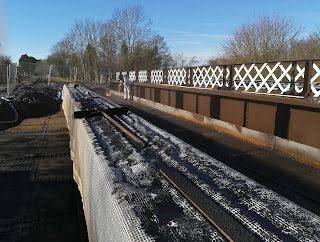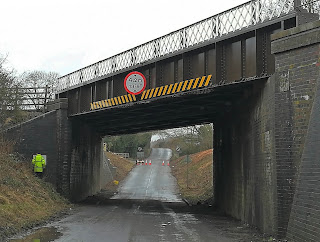BRIDGE 34 – GOTHERINGTON – FINAL REPORT & SUMMARY
ON REPAIRS (11.3.18)
This is the longest bridge on the railway and it had
leaking deck plates, leading to corrosion of major steel structural beams. Deep
ballast led to rotting of timber ballast boards and the vertical steel ballast
retaining plates. End of deck brick ballast retaining walls had partly
collapsed allowing ballast to slip onto the bearings and into the road. This
problem and, as the end of deck drains
were too high, allowed water to get onto the padstones and exacerbate the corrosion
of the steel and cause the padstone to wear quicker. Also some padstones were
too short and the steel was overhanging them. This led to vertical movement of
the track bearers when trains were passing. The main structural steelwork to
the underside of the bridge had not been cleaned or painted for at least 37
years (more likely 50 years) allowing corrosion to proceed more quickly. The
repair and construction works were completed in 7 weeks despite sub-zero
temperature mixed with almost continuous rain during January.
The following photos illustrate
samples of the problems and the work done to rectify them:-
1. Removing old ballast & waterproofing (5.1.18).
2. Encapsulating the entire bridge ready for shot
blasting and painting. (22.1.18)
3. Cross beam connection showing corrosion
(21.10.14).
4. Cross beam connection after blasting and painting
(2.2.18).
5. Cross girder notched and overhanging padstone
(29.1.18).
6. Cross girder repaired (28.1.18).
7. Track bearer corrosion and notching and overhanging
padstone (17.1.18).
8. Track bearer repair (28.1.18).
9. Padstone built up and grouted (also bottom flange
repair) (30.1.18).
10. Holes in
deck plates (8.1.18).
11. Cutting
plates for repairs (19.1.18).
12. Deck plate
repairs completed (28.1.18).
13. End drip
plates welded on (26.1.18).
14. Ballast
board and vertical steel ballast plate corrosion and timber ballast board rot
(10.1.18)
15. Down side showing replacement ballast plates (19.1.18).
16. Blast
cleaning deck for waterproofing (7.2.18).
17. Deck after
orange priming (8.2.18).
18. Up side
deck after waterproofing (white) (9.2.18).
19. View of
deck – down side quilted, up side waterproofed (9.2.18).
20. Up side
showing ballast walls being built (2.2.18).
21. View
showing end of deck drains (12.2.18).
22. Down side with sleeper
laying just started (21.2.18).
23. Down side
view with track re-laid (7.3.18).
25. View at road level towards Gotherington
26. View at Road level towards GrettonJohn Balderstone, Bridge Engineer.


























Thanks for posting the report Jo. Much appreciated. As with all railways they are only as good as their infrastructure. It is very instructive and confidence- building to see the care the relevant teams at GWSR are putting into this aspect of the railway. They should be very proud of the their work.
ReplyDeleteAs with the above comment, it does seem that the line is doing so much work that people do not see, they are there to ride on a steam train after all! The line is really looking good after all the work done by the various departments over the closed season and there is always more work to be done or is found. We do like to see these reports and your style of report is very good So thanks again to all the departments and we look forward to our next visit to the line.
ReplyDeleteRegards
Paul & Marion
John, thanks for your report on the completion of the repairs.
ReplyDeleteBrings back memories of the the works I carried out on various bridges on the big railway over the years.
Good to see you looking after the infrastructure. It is a never ending job unfortunately.
Well done, without the structures, there wouldn't be a railway.
Thanks John, As you will know, when you start to expose the main steelwork you can see things that are worse than was expected and simply cannot be left. This increased the work content by about 30% and we had to do some weekend work to get it finished in time. The surprising thing was how rotten and thin the vertical steel ballast plates had become. I can only conclude that as the ballast was over 300mm deep and was resting on the sloping timber this made the timber rot and kept the steel wet as well. It proved to be a long job to cut out the old and replace it all. Hopefully we won't need to touch it again for at least 25 years!
ReplyDeleteJohn, sometimes you only find these things out when you remove the track. Provided the waterproofing remains intact, it should be OK for years.
ReplyDelete